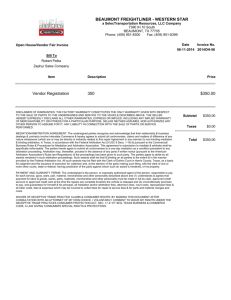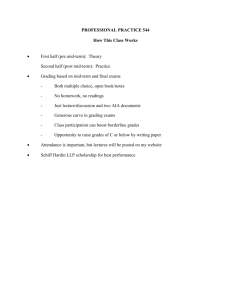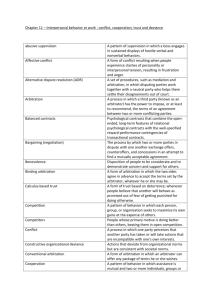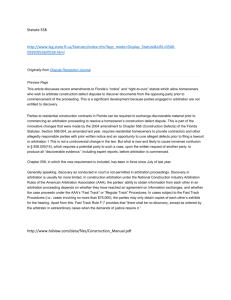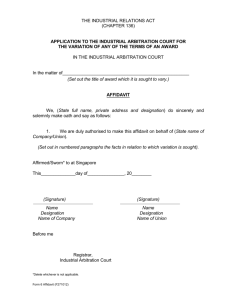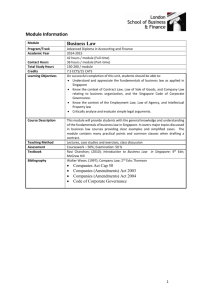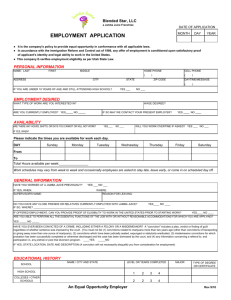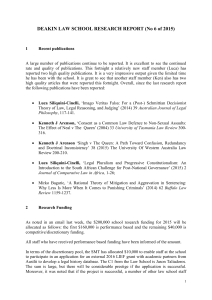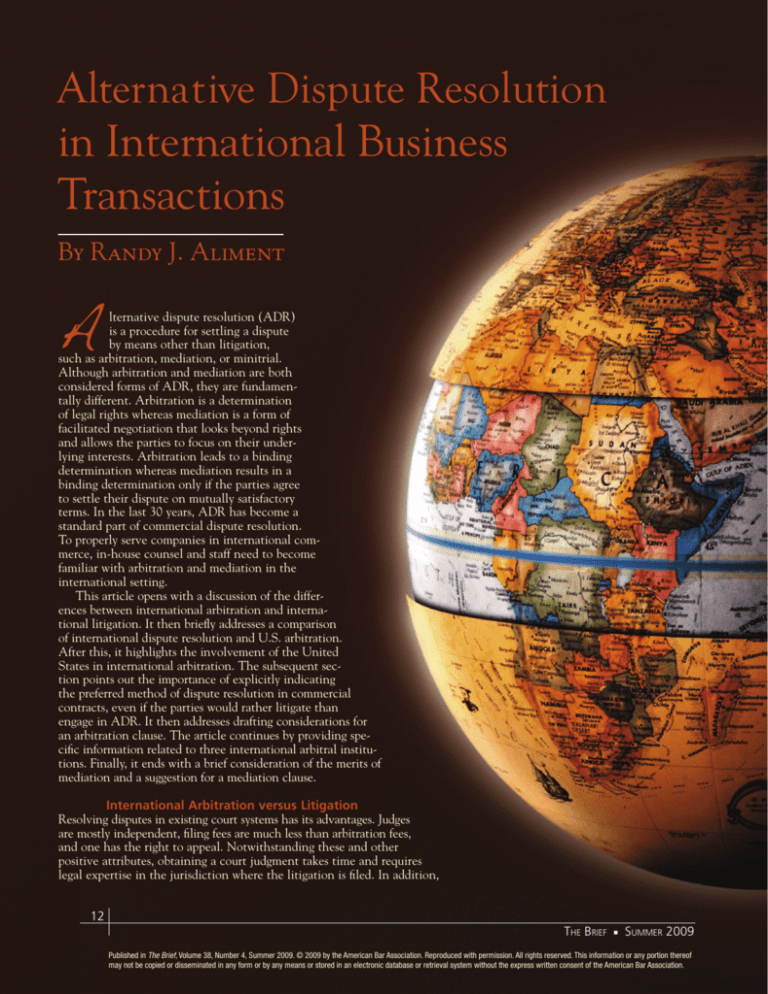
Alternative Dispute Resolution
in International Business
Transactions
By Randy J. Aliment
A
lternative dispute resolution (ADR)
is a procedure for settling a dispute
by means other than litigation,
such as arbitration, mediation, or minitrial.
Although arbitration and mediation are both
considered forms of ADR, they are fundamentally different. Arbitration is a determination
of legal rights whereas mediation is a form of
facilitated negotiation that looks beyond rights
and allows the parties to focus on their underlying interests. Arbitration leads to a binding
determination whereas mediation results in a
binding determination only if the parties agree
to settle their dispute on mutually satisfactory
terms. In the last 30 years, ADR has become a
standard part of commercial dispute resolution.
To properly serve companies in international commerce, in-house counsel and staff need to become
familiar with arbitration and mediation in the
international setting.
This article opens with a discussion of the differences between international arbitration and international litigation. It then briefly addresses a comparison
of international dispute resolution and U.S. arbitration.
After this, it highlights the involvement of the United
States in international arbitration. The subsequent section points out the importance of explicitly indicating
the preferred method of dispute resolution in commercial
contracts, even if the parties would rather litigate than
engage in ADR. It then addresses drafting considerations for
an arbitration clause. The article continues by providing specific information related to three international arbitral institutions. Finally, it ends with a brief consideration of the merits of
mediation and a suggestion for a mediation clause.
International Arbitration versus Litigation
Resolving disputes in existing court systems has its advantages. Judges
are mostly independent, filing fees are much less than arbitration fees,
and one has the right to appeal. Notwithstanding these and other
positive attributes, obtaining a court judgment takes time and requires
legal expertise in the jurisdiction where the litigation is filed. In addition,
12
The Brief
■
Summer 2009
Published in The Brief, Volume 38, Number 4, Summer 2009. © 2009 by the American Bar Association. Reproduced with permission. All rights reserved. This information or any portion thereof
may not be copied or disseminated in any form or by any means or stored in an electronic database or retrieval system without the express written consent of the American Bar Association.
businesses find it increasingly difficult to maintain their working relationships
in the midst of a public legal battle. In contrast, the confidential nature of
arbitration may take at least some of the sting out of a public business
conflict. The ability to select the arbitrator, the language of proceedings, and the place of hearings are other important reasons that favor
commercial arbitration. In addition, complicated rules of procedure
and evidence can be modified or excluded in arbitration but not
in court proceedings. The extent of the award or type of damages may be contemplated beforehand, which allows parties
to draft a proper arbitration clause and plan ahead with
appropriate reserves. Perhaps the greatest strength of international arbitration is the ability to fashion procedural
and substantive flexibility. Carefully drafted arbitration
clauses will likely result in significant control over the
way a dispute is decided and how much it will cost to
achieve resolution. Finally, enforcing an arbitration
award is typically easier than enforcing a civil judgment obtained in another country. For these and
other reasons, an estimated 90 percent of international contracts include an arbitration clause.1
Investors and corporations have increasingly
turned to international commercial arbitration
as the preferred method of dispute resolution of
international business disputes.2
Speed of resolution makes arbitration more
attractive than using the courts of most, if
not all, nations. Data collected by the U.S.
federal court system show the median time to
get to trial is over 23 months.3 In the United
States, the time from filing an arbitration
claim to reaching a decision is, on average,
16.7 months.4 According to the Londonbased Centre for Effective Dispute Resolution,
of the 3,000 commercial disputes subjected to
mediation in London each year, around 70 to
80 percent reach a settlement within one or
two days, with a further 10 to15 percent settling a few weeks later.5 The Korean Commercial
Arbitration Board maintains that matters brought
for international arbitration are, on average,
processed in five months, whereas similar matters
brought in the Korean court system can take two
to three years.6 Clearly, commercial arbitration offers
distinct time-saving benefits.
The enforceability of a court judgment versus that
of an arbitral award also favors using arbitration. No
effective international treaty facilitates the enforcement of
foreign judgments whereas the same is not true with respect
to arbitral awards. June 2008 marked the 50th anniversary of
the 1958 signing of the United Nations Convention on the Recognition and Enforcement of Foreign Arbitral Awards, also known
as the New York Convention. The New York Convention has been
described as “the single most important pillar on which the edifice of
international arbitration rests.”7 Since 142 countries out of the 192 current United Nations member states have adopted this Convention, the
Getty Images
The Brief
13
■
Summer 2009
Published in The Brief, Volume 38, Number 4, Summer 2009. © 2009 by the American Bar Association. Reproduced with permission. All rights reserved. This information or any portion thereof
may not be copied or disseminated in any form or by any means or stored in an electronic database or retrieval system without the express written consent of the American Bar Association.
majority of international arbitration
agreements are within its application.8 Under the New York Convention, if an arbitration award is issued
in any country that is a party to the
Convention, every other party to
the Convention is legally obligated
to enforce the award. Increasing
numbers of bilateral investment
treaties negotiated between foreign
states often include arbitration as a
means to resolve disputes between
foreign states and private overseas
investors.9 This ease of enforcement
is yet another reason why international arbitration continues to grow.
Article V of the New York
Convention enumerates the procedural grounds that serve as the only
means to prevent enforcement of
an arbitral award:
• the parties to the agreement
were, under the law applicable to them, under some
incapacity, or the agreement
is not valid under the law
to which the parties have
subjected it or the law of
the country where the award
was made;
• the party against whom the
award is invoked was not
given proper notice of the
appointment of the arbitrators or the proceedings or
was otherwise unable to
present its case;
• the award deals with matters
not within the scope of the
arbitration agreement, proRandy J. Aliment is a partner
in the Seattle, Washington, office
of Williams Kastner. His practice
emphasizes commercial litigation,
international law, and arbitration.
Aliment has been involved in transactions in Europe, the Middle East,
Canada, and China. He can be
reached at raliment@williamskastner.
com. He is grateful to Manish Borde
and Samantha Noonan, who assisted
with research for this article.
vided that if those matters
can be separated, then partial
enforcement of the award
that is within the scope of
the parties’ agreement may
occur;
• the composition of the tribunal or its procedure was
not in accordance with the
agreement of the parties or,
absent such agreement, not
in accordance with the law
of the country where the
arbitration took place;
• the award has not yet
become binding on the parties, or has been set aside or
suspended by a competent
authority of the country in
which or under the law of
which the award was made;
• the competent authority in
the country where recognition and enforcement is
sought finds that the subject
matter of the difference is not
capable of settlement by arbitration under the law of the
country where enforcement is
sought; or
• recognition or enforcement
of the award would be contrary to the public policy of
the country where enforcement is sought.
International versus U.S.
Dispute Resolution
Domestic arbitrations often take
on attributes of litigation, including the use of depositions, written
discovery, and document production. In international arbitrations,
significant surprises may arise for
the parties and counsel, including
whether witnesses will be permitted to testify, and if so, whether
they will be subject to cross-examination. If witnesses can testify,
rules govern whether they will be
subject to examination by counsel
and/or the arbitrator(s). Questions
such as these make it extremely
important to become familiar with
the procedural rules of the arbitral
institution before counsel drafts
an arbitration clause that binds
the parties to a specific venue to
resolve a future dispute.
Besides different rules and
language, there are other significant differences. The cultures,
perceptions, and values of the
participants, their counsel, and
the arbitrator(s) are richly diverse.
Legal procedures and traditions vary
greatly across the globe. The civil
law of continental Europe and the
common law of the United Kingdom have basic differences in the
style and content of pleadings, the
role and probative value of documents and testimony, the examination of witnesses, the disclosure of
information, the rules of evidence,
and the relationship and roles of
counsel and the arbitrator(s).
The common law prevails in
the United Kingdom, United
States, and most English-speaking
countries. The main features of the
common law approach to litigation
and arbitration are:
• early definition of the claims
and issues;
• equality of access to and
full disclosure of relevant
information;
• avoidance of surprise; and
• a gradual presentation with
rigorous examination of the
evidence at hearing (both
documents and oral testimony), largely at the discretion and control of counsel.
The civil law prevails in Continental Europe, Asia, Africa, and
South America. Key aspects of the
civil law approach to litigation and
arbitration include:
• an emphasis on privacy;
• the claimant carries the full
burden of proving its claim,
and one should not have to
incriminate oneself or assist
its adversary in the process;
• claims and issues evolve as
14
The Brief
■
Summer 2009
Published in The Brief, Volume 38, Number 4, Summer 2009. © 2009 by the American Bar Association. Reproduced with permission. All rights reserved. This information or any portion thereof
may not be copied or disseminated in any form or by any means or stored in an electronic database or retrieval system without the express written consent of the American Bar Association.
proceedings progress;
• the evidence is presented in
“dossiers” in advance of the
hearing;
• counsel argue about the
evidence and the law rather
than introducing and questioning witnesses;
• documentary evidence is
given great weight, whereas
oral testimony is given much
less weight;
• the judge or arbitrator(s) play
an active role in questioning
witnesses; and
• it is more of a consensual
process in which the parties
are expected and urged into
agreement on procedural
matters during the course of
the proceeding.
U.S. Involvement in
International Arbitration
International arbitration is not
“American litigation.” Further, in
international business and legal
communities, there is at least some
distrust of American-style litigation
and American lawyers. U.S. parties
and their legal teams should there-
fore recognize and be sensitive to
different values, comprehend different dynamics, adjust their expectations, and be flexible when litigating
in international arbitration. Successful international counsel possess
cultural sensitivity and an ability to
appreciate and bridge cultural differences. Counsel should also be familiar with different legal traditions
and be ready to adapt the presentation of evidence accordingly.
Evidence of American presence
in international commercial arbitration comes from data published
by the International Chamber of
Commerce’s (ICC) International
Court of Arbitration. Dezalay and
Garth describe the ICC as the
“central institution” in international commercial arbitration.10
Table 1 reports the number of
American parties in ICC arbitrations from 1980 to 2004.
While the number of American parties to ICC arbitration has
increased significantly from an
average of 70.4 per year from 1980
to 1988 to an average of 189.0 per
year from 2000 to 2004, so too has
the number of ICC arbitrations. As
a result, the relative share of American parties has remained largely
flat, increasing only from 11.2
percent during 1980–88 to 12.1
percent during 2000–04. That said,
America has been the nation most
frequently involved in ICC arbitrations for every year since 1998.11
Controlling the Dispute
Resolution Process
Dispute resolution must be considered in the overall risk assessment for the deal or project and is
essential to determine before any
contract is signed. Regardless of
whether the contracting parties
prefer arbitration, mediation, or litigation, the parties should identify
their preferred method of dispute
resolution in the contract. If the
contract is silent on this subject, a
party may be unable to engage in
litigation in a preferred forum due
to personal jurisdiction objections.
Moreover, confusion, delay, and
expense may be visited upon both
parties in the event of parallel litigation in competing jurisdictions,
with the possibility of conflicting
judgments. As long as differences
TABLE 1
Number of American Parties to ICC Arbitrations, 1980–2004
1980–88
1989–99
2000–04
301
574
481
(33.4)
(52.2)
(96.2)
333
628
464
(37.0)
(57.1)
(92.8)
634
1,202
945
(Average per year)
(70.4)
(109.3)
(189.0)
Total Parties
5,676
11,143
7,778
Percent American
11.2
10.8
12.1
Claimants
(Average per year)
Respondents
(Average per year)
Total American Parties
Sources: W. Laurence Craig et al., International Chamber of Commerce Arbitration 732, 734, tbl. 5 (3d ed. 2000); W. Laurence Craig et al.,
International Chamber of Commerce Arbitration app. 1-8, I-11, tbl. 5 (2d ed. 1990); and 2000–2004 Statistical Reports 12(1)–16(1), ICC
Int’l Ct. of Arb. Bull. (2001–2005).
15
The Brief
■
Summer 2009
Published in The Brief, Volume 38, Number 4, Summer 2009. © 2009 by the American Bar Association. Reproduced with permission. All rights reserved. This information or any portion thereof
may not be copied or disseminated in any form or by any means or stored in an electronic database or retrieval system without the express written consent of the American Bar Association.
Discovery of evidence from the
adverse party in international
arbitration is much more limited
than in U.S. arbitration.
exist in procedure and types of
damage awards across the world’s
courts, parties will have an incentive to file parallel proceedings.12
Besides forum shopping for the best
substantive law, parties will file
according to any perceived problem
with enforcement of a favorable
judgment.13 Thus, it is imperative
that a preference for litigation also
be explicitly recorded in the contract, specifically addressing choice
of law and venue.
Drafting the Arbitration
Provision
When a dispute arises between the
parties, the arbitration provision
suddenly becomes one of the most
important terms of the contract.
Counsel should not repeat the mistake of many who simply cut and
paste ambiguous or flawed arbitration clauses into their contracts. In
this context, the word “contract” is
extremely important since arbitration rights and duties arise from
the contract itself. When drafting
the arbitration provision, special
consideration must be given to the
(1) choice of forum, (2) choice
of law, (3) selection and number
of arbitrators, (4) language of the
proceedings, (5) discovery rights
and obligations, (6) remedies, and
(7) arbitration rules and/or the
arbitral institution.
The location of the arbitration
is extremely important. Parties
should select a country that is party
to the New York Convention to
help guarantee enforcement of the
arbitral award. In addition, the
procedural rules of arbitration are
usually governed by the laws of the
place of the arbitration. Accordingly, a court in the country where
the arbitration is held may overturn an arbitral award based upon
local procedural law governing the
arbitration.14 Drafters should also
contemplate any unique circumstances related to the transaction,
including the likely location of
any witnesses and evidence, travel
expenses, accessibility to satisfactory facilities, and a cost-effective
pool of available arbitrators.
Although the rules of arbitral
institutions usually serve to guide
the arbitrator in selecting what
substantive law to apply, parties should take advantage of the
fact that arbitrators must defer to
agreed-upon choice of law provisions. Because an arbitral institution’s default rules may point to
application of a country’s substantive law that is disadvantageous to
both parties, the choice of law issue
should be explicitly set forth in the
arbitration provision.
Parties can have the agreedupon arbitral institution select
the arbitrator or they may do so
themselves. Drafters who intend
to select the arbitrator(s) should
bear in mind any special qualifications they want the arbitrator(s)
to have (e.g., educational background, experience, and perhaps
substantive familiarity with the
subject matter of the transaction).
Although the selection of one arbitrator may save some costs and may
speed up the dispute resolution pro-
cess, drafters may want to opt for
a panel of three to maximize the
likelihood of receiving an evenhanded award. Moreover, a panel
may be deemed preferable where
the dispute is complicated or centers on a large amount of money.
If the parties speak different
languages, drafters should indicate
the language of the proceedings.
Not doing so may present difficulties with the arbitrator(s) selection process and unanticipated
expense related to communication
between the parties and with the
arbitrator(s). Note that it is still
beneficial to draft a language provision even if the contracting parties
share a common language since
the arbitration may take place in
a country with a language that is
unfamiliar to the parties and their
witnesses. As discussed herein, the
procedural rules of arbitral institutions usually address the language
in which the arbitration will be
conducted unless otherwise agreed
upon by the parties.
Discovery of evidence from
the adverse party in international
arbitration is typically much more
limited than what a contracting
party may be accustomed to, particularly a party from the United
Sates.15 If contracting parties desire
to broaden the scope of such discovery, drafters should explicitly
set forth certain procedures (e.g.,
access to opposing party’s hard and
electronic documents and the timing and perhaps duration of depositions). However, the parties must
take care not to draft a discovery
16
The Brief
■
Summer 2009
Published in The Brief, Volume 38, Number 4, Summer 2009. © 2009 by the American Bar Association. Reproduced with permission. All rights reserved. This information or any portion thereof
may not be copied or disseminated in any form or by any means or stored in an electronic database or retrieval system without the express written consent of the American Bar Association.
provision that is contradictory with
the laws of the arbitral forum.16
With respect to remedies, the
parties may want to limit exposure
to only compensatory damages.
Accordingly, drafters might want to
include a clause that limits certain
types of relief. On the other hand,
if the drafters do not wish to limit
an arbitrator’s power to grant relief,
they may include a provision that
the arbitrator has “the power to
adopt any appropriate remedy.”
The United Nations Commission on International Trade Law
(UNCITRAL) Arbitration Rules
is an example of a set of arbitration rules that is not part of an
administrative institution. The
rules provide a basis upon which
parties may agree to conduct arbitral proceedings and are used in ad
hoc arbitrations as well as administered arbitrations (many arbitral
institutions allow the proceedings
to be governed by the UNCITRAL Arbitration Rules). The rules
cover all aspects of the arbitral
process, including the appointment
of arbitrators, conduct of arbitral
proceedings, and effect of any
award.17 With the UNCITRAL
Arbitration Rules having been
adopted in more than 60 countries,
a uniform system of judicial review
of awards is developing.18
International arbitral institutions act much like courts concerning the management of the
arbitration proceedings. Services
may include the oversight of the
arbitrator selection process, the
forum for the hearing, the collection of applicable fees and awards,
and the interface between the parties or between the parties and the
arbitrator. Parties can choose from
a number of international arbitral
institutions, including the International Chamber of Commerce,
London Court of International
Arbitration, Stockholm Chamber of Commerce, Commercial
Arbitration and Mediation Center
for the Americas, Hong Kong
International Arbitration Centre,
Japan Commercial Arbitration
Association, American Arbitration
Association’s International Centre
for Dispute Resolution, British
Columbia International Commercial Arbitration Centre, and the
China International Economic and
Trade Arbitration Commission.
Model arbitration clauses.
When contracting parties desire to
have the UNCITRAL Arbitration
Rules govern, the following provision is useful:
Any dispute, controversy
or claim arising out of or
relating to this contract,
or the breach, termination,
or invalidity thereof, shall
be settled by arbitration
in accordance with the
UNCITRAL Arbitration
Rules as at present in force.
The appointing authority
shall be [name of person or
institution]. The number
of arbitrators shall be [one/
three]. The place of arbitration shall be [city and/or
country]. The language
to be used in the arbitral
proceedings shall be
[insert language].19
The following clauses are
meant to serve as model arbitration clauses for arbitration in the
American Arbitration Association’s
International Centre for Dispute
Resolution. Drafters, however,
should keep in mind any transaction-specific needs that should be
further addressed.
Any controversy or claim
arising out of or relating to
this contract, or the breach
thereof, shall be determined
by arbitration administered
by the International Centre
for Dispute Resolution in
accordance with its International Arbitration Rules.
The number of arbitrators
shall be [one or three]. The
place of arbitration shall be
[city and/or country]. The
language of the arbitration
shall be [insert language].20
Any controversy or claim
arising out of or relating to
this contract, or the breach
thereof, shall be determined
by arbitration administered
by the American Arbitration
Association in accordance
with its International Arbitration Rules. The place of
arbitration shall be [city and/
or country]. The language
of the arbitration shall be
[insert language].21
Contracting parties that would
like the China International
Economic and Trade Arbitration
Commission to govern any disputes
should contemplate use of the following language in their contracts:
Any dispute arising from or
in connection with this Contract shall be submitted to
the China International Economic and Trade Arbitration
Commission for arbitration
which shall be conducted in
accordance with the Commission’s arbitration rules in
effect at the time of applying
for arbitration. The arbitral
award is final and binding
upon both parties.22
International Arbitral
Institutions
While there are a number of international arbitral institutions, I
elaborate on the following solely for
the purpose of providing examples:
(1) the British Columbia International Commercial Arbitration
Centre (BCICAC), at www.bcicac.
com; (2) the China International
Economic and Trade Arbitration
Commission (CIETAC), at www.
cietac.org.cn/index_english.asp;
and (3) the American Arbitration
17
The Brief
■
Summer 2009
Published in The Brief, Volume 38, Number 4, Summer 2009. © 2009 by the American Bar Association. Reproduced with permission. All rights reserved. This information or any portion thereof
may not be copied or disseminated in any form or by any means or stored in an electronic database or retrieval system without the express written consent of the American Bar Association.
Association International Centre
for Dispute Resolution (ICDR), at
www.adr.org/sp.asp?id=28819. This
section highlights a select number
of the arbitration rules of each of
these institutions.
The BCICAC, in Vancouver,
British Columbia, is a not-for-profit
organization that was established in
1986. It was founded with the support of the governments of British
Columbia and Canada. Parties can
petition the BCICAC to administer a mediation or arbitration. The
BCICAC may assist with the selection of an appropriate and qualified mediator or arbitrator. The
BCICAC’s services also include
rules of procedure and assistance in
determining where and when proceedings are held.
The CIETAC was established in
1954 as the Foreign Trade Arbitration Commission and was renamed
in 1989. It operates under the
China Council for the Promotion
of International Trade. Since 2000,
the CIETAC has also been referred
to as the Arbitration Court of the
China Chamber of International
Commerce. The CIETAC headquarters is located in Beijing with
two subcommissions in Shanghai
and Shenzhen. The CIETAC also
has 19 liaison offices located in different regions throughout China.
The ICDR, the international
division of the American Arbitration Association, was established
in 1996. The ICDR has established
cooperative agreements with 62
arbitral institutions in 43 countries.
These agreements enable arbitration cases to be filed and heard in
any of these 43 nations. Once a
case is filed, case managers serve
as the court clerk and keep parties
apprised on the progress of their
case. The ICDR maintains a panel
of more than 400 independent
arbitrators and mediators located
across the globe.
Number of arbitrators. Unless
the parties can agree on the number
of arbitrators, the general rule under
the BCICAC Rules of Procedure
is for three arbitrators unless the
BCICAC determines, in its discretion, that there shall be a sole
arbitrator.23 Where three arbitrators
are to be appointed, each party is
to name one arbitrator, and the
two appointed arbitrators appoint
the remaining arbitrator, who is
to act as the presiding arbitrator.24
If a party fails to name an arbitrator, the other party can request the
BCICAC to appoint the arbitrator.25
Under circumstances where the
BCICAC is to select an arbitrator, it
will heed any qualifications required
of the arbitrator as agreed to by
the parties.26 Under the CIETAC’s
Commercial Arbitration Rules, the
arbitration tribunal may be composed of one or three arbitrators,
as agreed upon by the parties.27 If
the parties fail to agree and notify
the CIETAC or if the rules provide
otherwise, the tribunal will be composed of three arbitrators.28 Where
the arbitral tribunal is composed of
three arbitrators, the claimant and
respondent have 15 days from the
date of receipt of the notice of arbitration to appoint one arbitrator. If
a party fails to appoint or entrusts
the CIETAC chairman to appoint
an arbitrator on the party’s behalf,
then the chairman will automatically appoint an arbitrator.29 Within
15 days of the respondent’s receipt
of the notice of arbitration, the
presiding arbitrator will either be
jointly appointed by the parties or
appointed by the chairman upon
the parties’ joint authorization.30
With respect to the ICDR,
though the parties may mutually
agree upon any number of arbitrators, the general presumption is that
only one will be appointed if the
parties fail to reach a consensus.31
Notwithstanding the foregoing, the
administrator may determine that
three arbitrators are appropriate
because of the large size, complexity,
or other circumstances of the case.32
Commencing arbitral proceedings. The requirements for com-
mencing the arbitration under the
ICDR largely mirror those of the
BCICAC.33 An arbitral proceeding at the BCICAC is commenced
when a claimant delivers a notice
of request for arbitration to the
respondent(s) and BCICAC.34 The
notice of request for arbitration
must include a request that the dispute be referred to arbitration; the
names and addresses of the parties
to the dispute; a reference to the
arbitration clause or separate arbitration agreement relied upon; a
reference to the contract out of or
in relation to which the dispute has
arisen; the general nature of the
claim and an estimate of the value
of the dispute; the relief or remedy
sought; and the preferred number
of arbitrators, if not already agreed
upon. Additionally, the notice
of request for arbitration must be
accompanied by the required nonrefundable commencement fee per
the fee schedule.35
Although the manner in which
arbitration is commenced under
the CIETAC’s rules closely follows
the process under the BCICAC’s
rules, there are differences. For
example, the CIETAC request
for arbitration does not require a
reference to the contract out of or
in relation to which the dispute
has arisen, an estimated value of
the dispute, the relief or remedy
sought, or the preferred number
of arbitrators. Rather, in addition
to other BCICAC requirements,
a CIETAC request for arbitration
must include a statement of facts
and main issues in dispute, facts
and grounds upon which the claim
is based, and relevant evidence
supporting the facts upon which
the claim is based.36
Representation, witness testimony, and experts. Parties may
be represented or assisted by any
person during arbitral proceedings at the BCICAC, CIETAC or
ICDR. A BCICAC tribunal may
allow the evidence of a witness
to be presented in the form of a
18
The Brief
■
Summer 2009
Published in The Brief, Volume 38, Number 4, Summer 2009. © 2009 by the American Bar Association. Reproduced with permission. All rights reserved. This information or any portion thereof
may not be copied or disseminated in any form or by any means or stored in an electronic database or retrieval system without the express written consent of the American Bar Association.
written statement signed by the
witness.37 With regard to experts,
a BCICAC tribunal may appoint
one or more experts to report to it
on specific issues to be determined
by the panel and require a party to
give the expert any relevant information or to produce any relevant
documents or other property for
costs between the parties.42 The
CIETAC differs from the BCICAC
on this subject. Whereas the presumption in the BCICAC is that
the losing party bears the burden
of remuneration, the presumption
in the CIETAC is that the arbitration tribunal will determine the
allocation of the arbitration costs.43
rules are formulated in accordance
with the Arbitration Law of the
People’s Republic of China and
the “provisions of other relevant
laws. . . .”48 In addition, Article 4
of the CIETAC rules provides that
“[w]here the parties have agreed on
the application of other rules, or any
modification of these Rules, the par-
The newfound popularity of
international arbitration is directly
attributed to the growth in size
and complexity of disputes.
inspection by the expert.38 As is the
practice in a proceeding before the
BCICAC, evidence of witnesses
in an ICDR proceeding may also
be presented in the form of signed
written statements.39 If the ICDR
tribunal elects to employ an independent expert, the parties have
a right to question the expert at a
hearing.40 A CIETAC tribunal may
appoint experts or appraisers to
advise the tribunal with respect to
any necessary issues. Findings are
reported in an expert’s or appraiser’s
report. Additionally, after the submission of findings, at the request of
either party and with the approval
of the tribunal, the expert and
appraiser may be requested to provide explanations of their reports at
an oral hearing.41 Note that under
the BCICAC Rules of Procedure,
a tribunal may permit a party to
examine an expert but the party is
not necessarily entitled to do so.
Apportionment of costs. Under
Article 38 of the BCICAC rules,
the costs of the arbitration are to
be borne by the unsuccessful party
unless the tribunal determines that
it is appropriate to apportion the
Similarly, the ICDR tribunal will
apportion costs among the parties if
it determines such apportionment
to be reasonable.44 These costs may
also include the reasonable fees for
the successful party.
Language of the proceedings
and applicable substantive law.
Determination of the language to
be used in the proceedings is based
on the submissions of the parties
and the language of the arbitration agreement in both BCICAC
and CIETAC proceedings. However, absent such agreement, the
Chinese language shall be used in
CIETAC proceedings.45 In ICDR
proceedings, the language shall be
that of the documents containing
the arbitration agreement unless
the tribunal determines otherwise.46
The ICDR and BCICAC take
similar positions with respect to
ascertaining what substantive law
applies to the dispute. Where there
is no agreement, the BCICAC
applies “the rules of law it considers to be appropriate given all the
circumstances . . . .”47 Article 28
of the ICDR’s rules uses similar
language. The CIETAC arbitration
ties’ agreement shall prevail except
where such agreement is inoperative or in conflict with a mandatory
provision of the law of the place
of arbitration.” Article 145 of the
People’s Republic of China General
Principles of Civil Law provides:
“The parties to a contract involving foreign interests may choose the
law applicable to settlement of their
contractual disputes, except as otherwise stipulated by law. If the parties to a contract involving foreign
interests have not made a choice,
the law of the country to which the
contract is most closely connected
shall be applied.”49 In the absence
of any express choice of law by the
parties to a foreign-related arbitration, the tribunal will apply such
law as it determines appropriate.
Trends and Strategies
Commonly praised as a more effective and efficient alternative to
international litigation, international arbitration has been scrutinized for shortfalls traditionally
associated with litigation, including
excessive costs and lengthy duration
of proceedings. This criticism comes
20
The Brief
■
Summer 2009
Published in The Brief, Volume 38, Number 4, Summer 2009. © 2009 by the American Bar Association. Reproduced with permission. All rights reserved. This information or any portion thereof
may not be copied or disseminated in any form or by any means or stored in an electronic database or retrieval system without the express written consent of the American Bar Association.
concomitantly with an increased
number of parties that have turned
to international arbitration as their
preferred method of dispute resolution.50 The newfound popularity of
international arbitration is directly
attributed to the growth in size and
complexity of disputes.51
To meet the expectations of
international commerce and to
preserve certain advantages over
traditional forms of dispute resolution, arbitration proceedings must
remain time and cost efficient.
Strategies to best manage cost
and duration of proceedings are
currently being addressed by a
number of developments in the
international business, court, and
arbitral communities. Examples
of such developments include a
prospective review of the New
York Convention to ensure that
the demands of modern arbitration
are being met and an increased
adoption of the UNCITRAL
Arbitration Rules to further the
development of a uniform system
of judicial review of awards and
the maintenance of the policy
choice of limited review of awards.
The U.S. Supreme Court’s March
2008 decision in Hall Street Associates LLC v. Mattel, Inc.52 held that
the scope of judicial review of an
arbitral award is exclusively determined by the Federal Arbitration
Act.53 The decision effectively nullifies any contractual provision that
expands or narrows judicial review
of arbitral awards under Title 9.54
Although every arbitration
proceeding is different, counsel can
and should plan for the appropriate
level of complexity and associated
costs required for the proceeding.
The exercise of risk assessment and
proper planning can assist parties to
create a well-tailored strategy and
approach to the arbitration. For
example, parties may choose to take
advantage of procedural flexibilities
and elect to have one instead of
three arbitrators, limit discovery and
number of experts, and/or elect to
change the site of the arbitration
from a large, expensive metropolitan
city to an alternate location more
convenient for the parties and witnesses. This combination of smallscale and large developments in the
international arbitration arena can
help better meet the expectations of
the international commercial community while avoiding the excessive
costs and lengthy duration associated with litigation.
Mediation
Mediation refers to a method of
nonbinding dispute resolution
involving a neutral third party who
tries to help the disputing parties
reach a mutually agreeable solution. As opposed to an arbitrator, a
mediator does not render a decision
but merely helps the parties identify the source(s) of the dispute.
Many international arbitral institutions also provide mediation services, including the London Court
of International Arbitration, the
ICC, the ICDR, and the BCICAC.
The U.S. experience. In the
United States, the use and acceptance of ADR is well established
and is now an integral part of the
legal system. Mediation is required
by the federal rules in many districts.55 Many states also have
mediation and arbitration statutes.
There is a Uniform Mediation
Act56 and most U.S. courts have
some ADR requirement. The
familiarity and relative regency of
ADR in the United States have
spawned a generation of lawyers
accustomed to ADR who have
begun second careers as mediators
and arbitrators after distinguished
legal and judicial careers.
Established nearly three decades
ago, JAMS (Judicial Arbitration
and Mediation Service) is America’s largest arbitration and mediation service and has more than 200
full-time “neutrals,” mostly former
judges, attorneys, or law professors. It handles about 10,000 cases
a year worldwide and now has its
own set of international mediation
and arbitration rules.57 The impact
arbitration and mediation has had
on litigation in the courts has been
significant. According to The Economist, conventional litigation is suffering, and some have described the
process as “the vanishing trial.”58
It has been estimated that 11 percent of civil cases went to court in
1962. That number has now fallen
to under 2 percent. The number of
federal court tort cases that ended
in a trial dropped by nearly fourfifths between 1985 and 2003.59
Mediation has not always been
universally accepted in the United
States. In the 1970s and ’80s,
before JAMS and other new ADR
service businesses, mediation services were performed by the courts.
The trial judge would assign mediation to another judge, the settlement judge. While this preserved
the neutrality of the trial judge, was
inexpensive, and the settlement
judge was allowed to meet privately
with each party, it was and is a less
than satisfactory process. Busy trial
court judges have little time to prepare for and conduct what can and
often should be a daylong effort to
resolve a dispute upon a facilitated
mutual agreement.
Cultural differences with
international mediation. Recognizing that cultural misunderstanding
can occur from the differences
between ADR in the United States
and elsewhere is important. Even
the terminology is different, with
“mediation” used in common law
jurisdictions and “conciliation” in
some civil law jurisdictions, such
as Spain. U.S. and foreign parties
might think they are planning for
the same process when U.S. mediation and international conciliation
can be quite different.
When someone in the United
States mentions mediation as part
of a legal proceeding, most know
exactly what is meant. There
are important differences, however, between common and civil
21
The Brief
■
Summer 2009
Published in The Brief, Volume 38, Number 4, Summer 2009. © 2009 by the American Bar Association. Reproduced with permission. All rights reserved. This information or any portion thereof
may not be copied or disseminated in any form or by any means or stored in an electronic database or retrieval system without the express written consent of the American Bar Association.
law jurisdictions. Mechanisms
to protect the confidentiality of
statements and offers made in
negotiations are more developed
in common law countries. Common law judges tend to preserve
neutrality by avoiding the settlement process. Some continental
European legal systems, like the
Swiss and German, have judge-led
settlement efforts. U.S. attorneys
tend to have more contact with
the other parties’ legal representative during discovery. The practice
in continental Europe involves
more written than oral communications and does not use the
same discovery process used in the
United States. U.S. lawyers regularly watch their clients speak at
length because of the U.S. deposition process. Many international
lawyers tend to use written presentations and are not so accustomed
to watching clients speak in court
or at mediation. Common witness
preparation in the United States
may even violate some professional
ethics rules in other countries.
Litigation in the United States
is thought to be more costly and
disruptive than in civil law jurisdictions. The more reasonable cost of
international justice has been cited
as a reason for the slow acceptance
of ADR in other countries.60
Drafting mediation provisions. When drafting a mediation
provision, one should be sure to
(1) set forth a clear requirement to
mediate before using other dispute
resolution alternatives, (2) decide
whether the mediator should also
function as the arbitrator if mediation fails to resolve the entire
dispute, (3) consider using the
rules of one of the international
institutions, and (4) set forth what
steps are to be taken if mediation
fails.61 I strongly recommend that
the mediator be different from
the arbitrator since a different
mediator promotes open and frank
discussions that are more likely to
lead to an agreed upon settlement.
The following is a model mediation provision that parties may
deem appropriate for their contract:
If a dispute arises out of or
relates to this contract, or
the breach thereof, and if
the dispute cannot be settled
through negotiation, the parties agree first to try in good
faith to settle the dispute by
mediation administered by
the [preferred institution]
under its [mediation rules
of the preferred institution]
before resorting to arbitration, litigation, or some other
dispute resolution procedure.
Conclusion
The international business community requires the quick and efficient
resolution of commercial disputes.
Attorneys involved in international
commercial disputes should properly
advise their clients on the availability and attractiveness of international ADR, whether it be in the
form of arbitration or mediation.
Whatever type or combination
of ADR is chosen, parties should
be sensitive to the differences in
understanding of the ADR process
often held by opposing parties to an
international commercial dispute.
Up-front planning and communication on this subject, before the
dispute arises, will go a long way
toward controlling costs and will
likely lead to a more satisfactory
dispute resolution process. ■
Notes
1. Klaus Peter Berger, International
Economic Arbitration 8 & n.62 (1993)
(citing Albert Jan van den Berg et
al., Arbitragerecht [Law on Arbitration] 134 (1988)); see also Towards a
Science of International Arbitration: Collected Empirical Research
59 (Christopher R. Drahozal & Richard
W. Naimark eds., 2005) (finding that
88.2 percent of a small sample of transnational joint venture contracts include
arbitration clauses).
2. Press Release, Pricewaterhouse
Coopers and Queen Mary University of
London, International Arbitration: Corporate Attitudes and Practices (2006),
www.pwc.com/extweb/pwcpublications.
nsf/docid/B6C01BC8008DD576802571
71003177F0.
3. See Federal Judicial Caseload
Statistics, www.uscourts.gov/
caseloadstatistics.html.
4. Knocking Heads Together; Mediation. (No Need to Sue), Economist (U.S.
ed.), Feb. 3, 2007, 60, 60.
5. Id.
6. Chul-Gyoo Park, A Comparative Analysis of Arbitral Institutions and
Their Achievements in the United States
and Korea, 15 Am. Rev. Int’l Arb. 475,
488–89 (2004).
7. J. Gillis Wetter, The Present Status
of the International Court of Arbitration of
the ICC: An Appraisal, 1 Am. Rev. Int’l
Arb. 91, 93 (1990).
8. See 1958—Convention on the
Recognition and Enforcement of Foreign
Arbitral Awards, www.uncitral.org/
uncitral/en/uncitral_texts/arbitration/
NYConvention_ status.html.
9. See Press Release, UNCTAD,
Analysis of Bilateral Investment Treaties Finds Growth in Agreements, New
Areas of Focus, Apr. 12, 2007, www.
unctad.org/Templates/webflyer.asp?docid
=8270&intItemID=4431& lang=1.
10. Yves Dezalay & Bryant G.
Garth, Dealing in Virtue: International Commercial Arbitration and
the Construction of a Transnational Legal Order 45 (1996).
11. See 1998–2004 Statistical Reports
10(1)–16(1), ICC Int’l Ct. of Arb.
Bull. (1999–2005).
12. Louise Ellen Tietz, Taking Multiple Bites of the Apple: A Proposal to
Resolve Conflicts of Jurisdiction and Multiple Proceedings, 26 Int’l Law. 21 (1992).
13. Id.
14. Alghanim & Sons v. Toys “R”
Us, Inc, 126 F.3d 15, 23 (2d Cir. 1997).
15. Javier H. Rubinstein, International Commercial Arbitration: Reflections
at the Crossroads of the Common Law and
Civil Law Traditions, 5 Chi J. Int’l L.
303 (2004).
16. Deborah L. Holland, Comment,
22
The Brief
■
Summer 2009
Published in The Brief, Volume 38, Number 4, Summer 2009. © 2009 by the American Bar Association. Reproduced with permission. All rights reserved. This information or any portion thereof
may not be copied or disseminated in any form or by any means or stored in an electronic database or retrieval system without the express written consent of the American Bar Association.
Drafting a Dispute Resolution Provision
in International Commercial Contracts,
7 Tulsa J. Comp. & Int’l L. 451, 472
(2000) (citing Donald Francis Donovan & David W. Rivkin, International
Arbitration and Dispute Resolution, 786
PLI/Comm. 143, 155 (1999)).
17. United Nations Commission on
International Trade Law, UNCITRAL
Arbitration Rules, www.uncitral.org/
uncitral/en/uncitral_texts/arbitration/
1976Arbitration_rules.html.
18. See United Nations Commission
on International Trade Law, FAQ—Origin, Mandate, and Composition of
UNCITRAL, www.uncitral.org/uncitral/
en/about/origin_faq.html.
19. Holland, supra note 16, at 476
(citing Robert Donald Fischer & Roger
S. Haydock, International Commercial
Disputes: Drafting an Enforceable Arbitration Agreement, 21 Wm. Mitchell L.
Rev. 941, 983 (1996)).
20. American Arbitration Association, International Dispute Resolution
Procedures (2003) (pamphlet).
21. Id.
22. China International Economic
and Trade Arbitration Commission
Model Arbitration Clause, www.cietac.
org.cn/english/model_clause/model_
clause.htm.
23. British Columbia International
Commercial Arbitration Centre,
International Commercial Arbitration
Rules of Procedure, art. 5 [hereinafter
BCICAC Rules], www.bcicac.com/bci-
cac_ica_rules.php#FeeSchedule.
24. BCICAC Rules, art. 7.
25. Id.
26. Id., art. 8.
27. China International Economic
and Trade Arbitration Commission
Arbitration Rules, art. 20 [hereinafter
CIETAC Rules], www.cietac.org.cn/
english/rules/htm.
28. Id.
29. Id., art. 22.
30. Id.
31. American Arbitration Association, International Centre for
Dispute Resolution, International
Dispute Resolution Procedures, art. 5
[hereinafter ICDR Rules], www.adr.
org/sp.asp?id=33994#5.
32. Id.
33. Id., art. 2.
34. BCICAC Rules, art. 17.
35. Id. In addition, please see id.,
art. 40.
36. CIETAC Rules, art. 10.
37. BCICAC Rules, art. 27.
38. Id., art. 29.
39. ICDR Rules, art. 20.
40. Id., art. 22
41. CIETAC Rules, art. 38.
42. BCICAC Rules, art. 38.
43. CIETAC Rules, art. 43.
44. ICDR Rules, art. 3.
45. CIETAC Rules, art. 67.
46. ICDR Rules, art. 14.
47. BCICAC Rules, art. 30.
48. CIETAC Rules, art. 1.
49. General Principles of the Civil
Law of the People’s Republic of China,
art. 145, http://en.chinacourt.org/public/
detail.php?id=2696.
50. Press Release, supra note 2.
51. Michael Goldhaber, Sneak Peek,
An Inside Look at More than 100 Major
Disputes from the Secret World of Arbitration, Am. Law., June 2005 (Supp.), at S22.
52. 128 S. Ct. 1396 (2008).
53. 9 U.S.C. §§ 1–16.
54. Id. at 1406.
55. Fed. R. Civ. Proc. 39(1).
56. Nat’l Conference of Comm’rs
on Unif. State Laws, Uniform Mediation Act (amended 2003), www.law.
upenn.edu/bll/archives/ulc/mediat/
2003finaldraft.htm.
57. Both sets of rules can be found
at www.jamsadr.com/rules/international_
rules.asp.
58. Knocking Heads Together; Mediation. (No Need to Sue), supra note 4.
59. Id.
60. Sergio Chiarloni, Civil Justice
and Its Paradoxes: An Italian Perspective 263, in Civil Justice in Crisis:
Comparative Perspectives of Civil
Procedure (Adrian A. S. Zuckerman
1999); Peter Gottwald, Civil Justice
Reform: Access, Cost, and Expedition:
The German Perspective 207, in Civil
Justice in Crisis: Comparative Perspectives of Civil Procedure (Adrian
A. S. Zuckerman 1999).
61. Holland, supra note 16, at
459–61.
23
The Brief
■
Summer 2009
Published in The Brief, Volume 38, Number 4, Summer 2009. © 2009 by the American Bar Association. Reproduced with permission. All rights reserved. This information or any portion thereof
may not be copied or disseminated in any form or by any means or stored in an electronic database or retrieval system without the express written consent of the American Bar Association.


